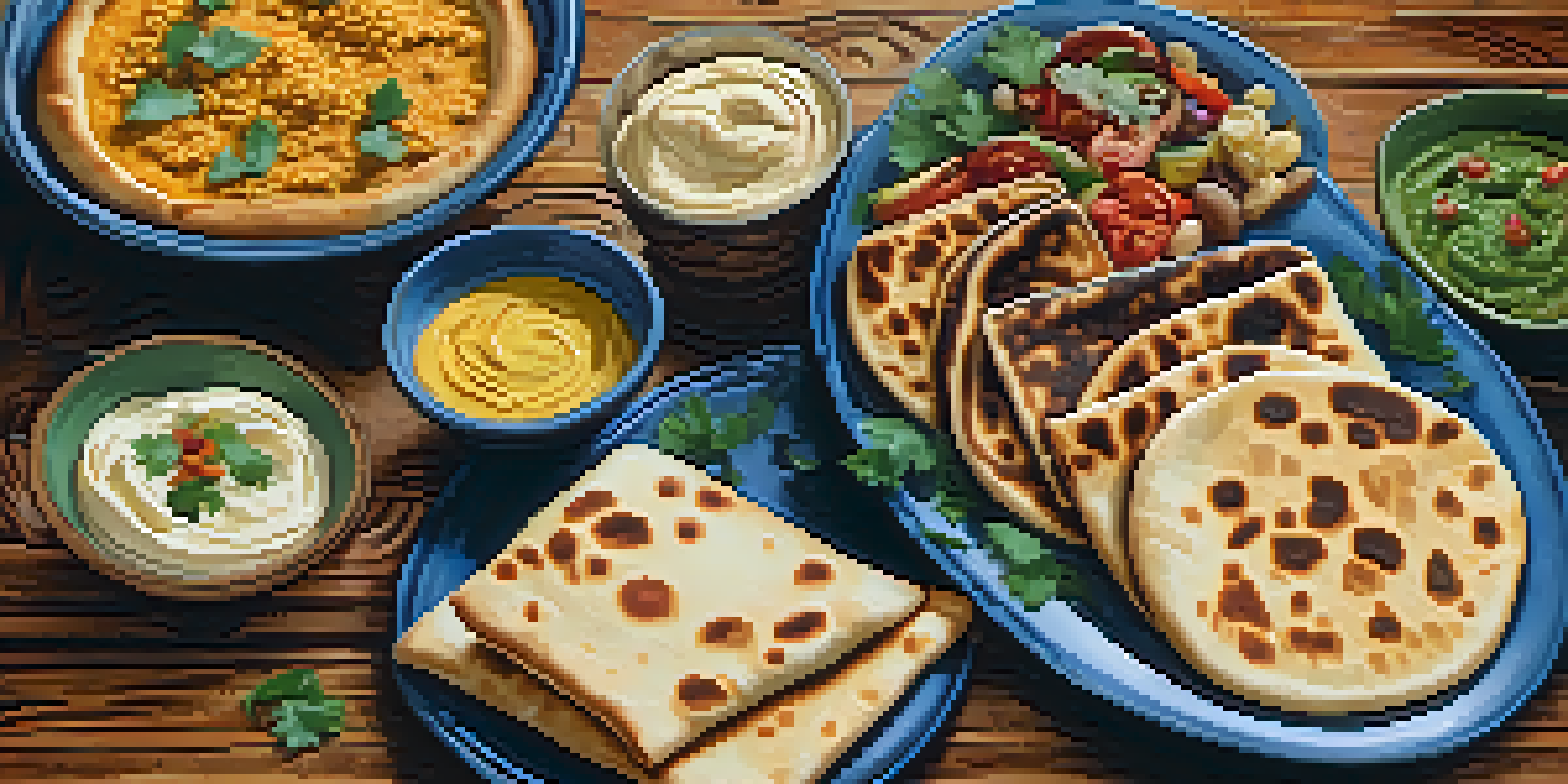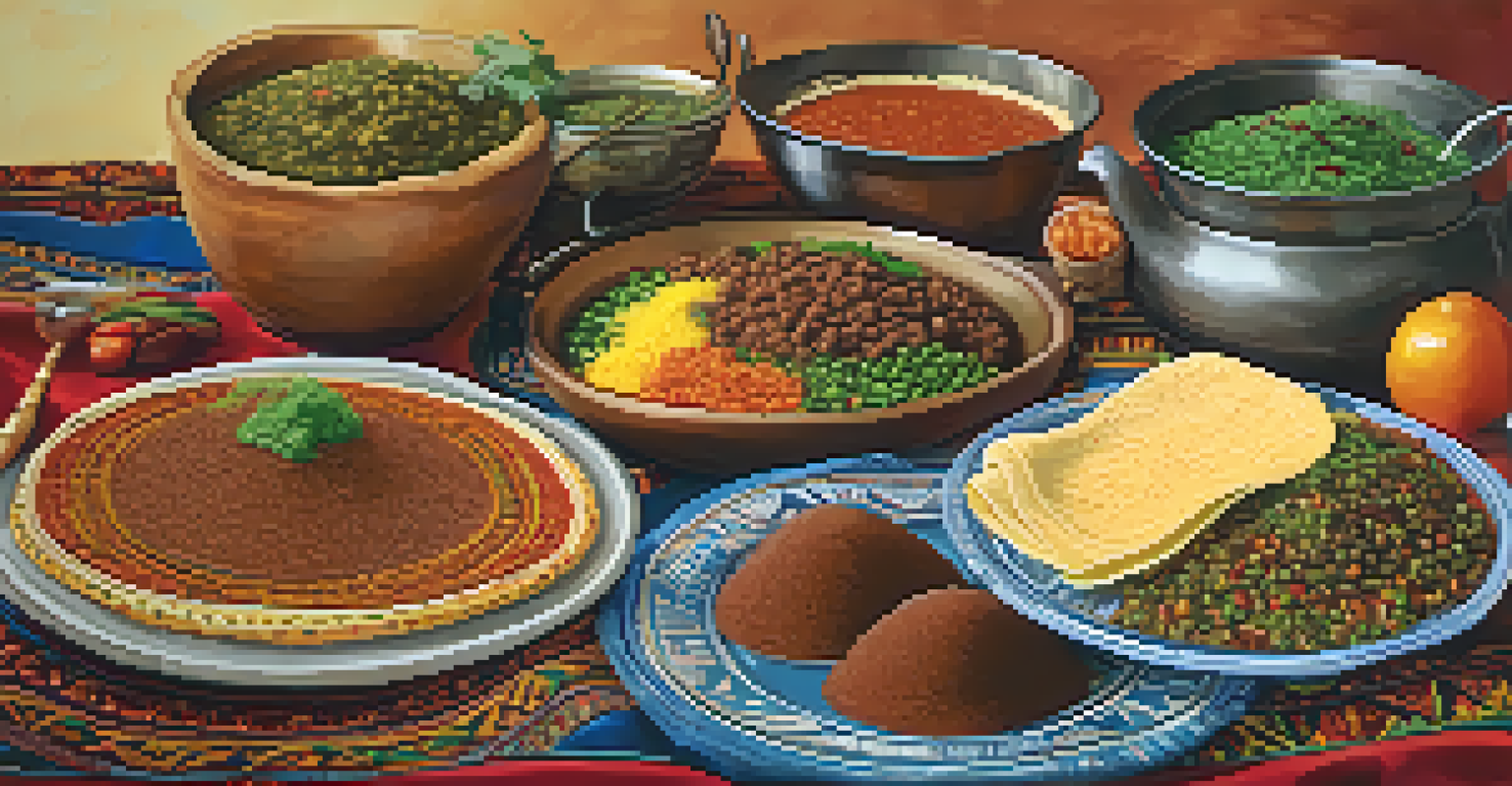Flatbreads Around the World: Recipes and Cultural Insights

What Are Flatbreads? A Global Perspective
Flatbreads are unleavened or minimally leavened breads shaped flat and cooked on a hot surface. Found in various cultures, they serve as a staple food, often accompanying meals or used as a base for toppings. Their simplicity and versatility have allowed them to adapt to different culinary traditions, making them a beloved choice worldwide.
Bread is the staff of life.
From the naan of India to the tortillas of Mexico, each type of flatbread carries unique flavors and textures. They can be made from a variety of grains, including wheat, corn, and even rice, depending on regional preferences. The beauty of flatbreads lies in their ability to reflect the agricultural landscape and cultural practices of the areas they come from.
Understanding flatbreads involves appreciating their role in the meals and customs of a given culture. Whether used for wrapping, dipping, or serving, flatbreads enhance the dining experience by providing a delicious accompaniment to various dishes.
Naan: The Pillowy Delight of South Asia
Naan is a soft, pillowy flatbread that originates from the Indian subcontinent. Traditionally made with white flour, yogurt, and yeast, it is cooked in a tandoor, giving it a unique smoky flavor. Whether served plain or stuffed with ingredients like cheese or garlic, naan has become a favorite in Indian cuisine.

Often enjoyed with rich, flavorful curries, naan serves as a perfect vehicle for scooping up sauces and meats. It’s not just a side dish; it’s an integral part of the Indian dining experience, symbolizing hospitality and warmth. Many families have their own recipes passed down through generations, making each naan special.
Flatbreads: Global Culinary Staples
Flatbreads are versatile, unleavened breads that vary by culture, reflecting local agricultural practices and culinary traditions.
Making naan at home can be a fun experience. With just a few ingredients and some practice, you can create a delicious flatbread that brings the taste of India right into your kitchen.
Tortillas: The Heart of Mexican Cuisine
Tortillas are a staple in Mexican cuisine, made primarily from corn or wheat. The process of making corn tortillas, known as nixtamalization, involves soaking corn in lime water, which enhances flavor and nutritional value. This ancient method speaks to the rich history and culinary traditions of Mexico.
Food is not just what we eat; it’s a way to connect with culture and community.
Tortillas are incredibly versatile, used in dishes ranging from tacos to enchiladas and quesadillas. Their ability to hold a variety of fillings makes them essential in Mexican meals. Additionally, they are often enjoyed with salsas, beans, and meats, creating a symphony of flavors and textures.
To make authentic tortillas at home, all you need are simple ingredients and some practice. Rolling them out can be a fun family activity, bringing everyone together to share in the experience of creating something delicious.
Pita: The Pocket Bread of the Middle East
Pita is a round, pocket-style flatbread that has its roots in the Middle East. Made from wheat flour and water, its unique puffing technique occurs during baking, creating a pocket that can be filled with various ingredients. This feature makes pita a popular choice for sandwiches and wraps.
Traditionally served with dips like hummus and baba ghanoush, pita is a versatile bread that complements many Middle Eastern dishes. Its soft texture and chewy bite provide a perfect balance to flavorful fillings, making it a favorite across the globe. Moreover, it can be used to scoop up salads or even grilled meats.
Naan and Tortillas: Cultural Icons
Naan and tortillas serve as essential components in Indian and Mexican cuisines, respectively, enhancing meals with their unique textures and flavors.
Making pita at home can be a delightful and rewarding experience. With just flour, water, and yeast, you can recreate this timeless bread and enjoy it fresh from the oven, elevating your meals to new heights.
Lavaš: The Thin Bread of Armenia and Beyond
Lavaš is a thin, soft flatbread that hails from Armenia and is popular in various surrounding regions. It’s made from simple ingredients like flour, water, and salt, and is traditionally baked in a clay oven called a tandoor. Its thinness allows it to be easily rolled, folded, or served as a wrap for various dishes.
In Armenian culture, lavaš is more than just food; it’s a symbol of hospitality and family gatherings. Often enjoyed with grilled meats or as part of a meze platter, it plays a significant role in communal dining experiences. The bread is sometimes used to wrap food, keeping it warm and enhancing the flavors.
Making lavaš at home can be an enjoyable way to connect with Armenian culture. The process of rolling out the dough and baking it creates a fun atmosphere, perfect for family gatherings or dinner parties.
Focaccia: The Italian Flatbread with a Twist
Focaccia is an Italian flatbread known for its rich flavor and airy texture. It’s made with olive oil, flour, salt, and yeast, resulting in a dough that rises beautifully. Often topped with herbs, garlic, or even olives, focaccia is a delightful addition to any meal or enjoyed on its own.
This versatile bread can be served as an appetizer, side dish, or even a base for sandwiches. Its golden-brown crust and soft interior make it irresistible, while the toppings add bursts of flavor. Focaccia is commonly found in Italian bakeries, but it’s easy to replicate at home.
Homemade Flatbreads: A Fun Experience
Making flatbreads like pita, focaccia, and injera at home can be a delightful activity that connects families to cultural traditions and flavors.
Baking focaccia can be a creative process, allowing you to experiment with different toppings and flavors. Whether you prefer rosemary and sea salt or a more adventurous topping, the result is always a delicious flatbread that will impress your family and friends.
Injera: The Spongy Bread of Ethiopia
Injera is a traditional Ethiopian flatbread made from teff flour, known for its unique sour taste and spongy texture. This fermented bread serves as both a plate and utensil in Ethiopian cuisine, absorbing flavors from various stews and dishes served atop it. Its cultural significance is immense, often central to communal dining experiences.
Injera is typically served with a variety of colorful stews, known as wot, which are scooped up using pieces of the bread. This communal eating style fosters a sense of togetherness, highlighting the importance of sharing meals in Ethiopian culture. The bread itself is a vital source of nutrients, thanks to the teff grain.

Making injera at home may require some practice, especially with the fermentation process. However, the end result is a delicious flatbread that not only tastes great but also connects you to the rich traditions of Ethiopian culture.